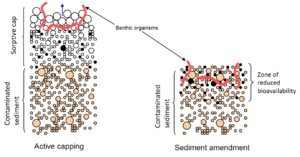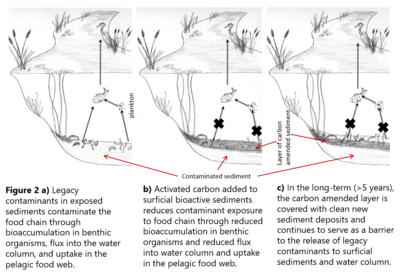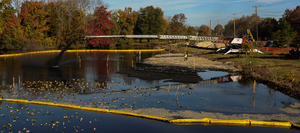User:Debra Tabron/sandbox
Activated carbon (AC) can be used to reduce contaminant flux from sediments to surface water and subsequently reduce contaminant uptake by plants and animals. Multiple field-scale demonstrations and final remedies have been completed in which AC was incorporated into the sediment bioactive zone or added as a thin-layer cap over the top of the sediments. Incorporation of AC into the bioactive zone has less impact on the existing flora and fauna but is only applicable to lower energy environments (wetlands, slow moving rivers and lakes). In higher energy environments where sediment erosion may occur, AC may be applied as a separate layer or blended with other capping materials. When considering AC addition to sediments, the reductions in contaminant flux to surface water and contaminant uptake by biota should be weighed against potential negative ecological effects.
Related Article(s):
- Contaminated Sediments - Introduction
- Sediments - Capping (coming soon)
- In Situ Groundwater Treatment with Activated Carbon
CONTRIBUTOR(S): Dr. Upal Ghosh
Key Resource(s):
- Strategic Environmental Research and Development Program and Environmental Security Technology Certification Program (SERDP/ESTCP), 2020. In-place Remediation Technologies for Contaminated Sediments[1] Areas/Environmental-Restoration/Contaminated-Sediments/In-place-Remediation</ref>
- U.S. Environmental Protection Agency (USEPA), 2013. Use of Amendments for In Situ Remediation at Superfund Sediment Sites. Office of Superfund Remediation and Technology Innovation. OSWER Directive 9200.2-128FS[2]
Introduction
Research over the last two decades has demonstrated that native black carbon particles in sediments (e.g. soot, coal, and charcoal) very strongly bind hydrophobic organic compounds (HOCs). When present in sediments (both natural and anthropogenic), these materials reduce contaminant exposure[3][4][5], often by one order of magnitude or more compared to natural organic matter. This observation of natural contaminant sequestration in native black carbon particles has led to the approach of enhancing native sorption by introducing clean, manufactured black carbon materials such as activated carbon into sediments which provides a novel approach for in situ management of contaminated sediments[4]. While historically, most sediment remedies have involved sediment removal, there is growing interest in treating contaminated sediments in situ, especially through the use of amendments as described in a US EPA Directive[2].
In situ sediment treatment commonly involves the addition of amendments to accelerate contaminant removal and/or immobilize the contaminant[6]. Amendments that have been considered for sediment treatment include organophilic clay, zeolites, bauxite, iron oxide/hydroxide, apatite, zero valent iron and activated carbon[7].
Activated carbon (AC) has a strong affinity for a wide range of toxic chemicals and has been used to treat air discharges, potable water, wastewater, and groundwater. Strong sorbents including AC have not traditionally been used for management of contaminated sediments. However, recent work has investigated the use of AC as a thin-layer cap or incorporated into the sediment to reduce contaminant exposure to native organisms [8][4]).
In situ treatment via contaminant immobilization is an innovative sediment remediation approach that involves introducing sorbent amendments such as activated carbon (AC) into contaminated sediments to alter sediment geochemistry, increase contaminant binding, and decrease bioavailability. A variation of this approach involves placement of an activated carbon barrier layer as part of an active cap over contaminated sediments. The use of activated carbon as in situ sediment treatment versus its use as an active cap is illustrated in Figure 1. When used for in situ treatment, the AC is incorporated into the surficial bioactive zone of sediments. An active cap involves placement of a new layer of cap materials (typically sand) that includes a strong sorbent dispersed within the cap or placed as part of a multi-layer cap. A recent innovation in in situ remediation includes the addition of microbial degraders along with AC to break down the adsorbed pollutants over time[9].
In Situ AC Amendment
As illustrated in Figure 1, in situ treatment with a sorbent amendment targets the bioactive zone of sediments that can range from 2” in freshwater sediments to nearly 12” in some marine environments. The surficial bioactive zone is considered to be the zone that primarily contributes to exposure though bioaccumulation in benthic organisms and also through chemical flux into the surface water. Amendment of this zone with a suitable strong sorbent can result in the reduction of freely dissolved porewater concentrations of chemicals in sediments and therefore reduced bioavailability. A typical amendment dose (5% dry weight) has minimal impact on sediment bathymetry and is suitable where altering the depth of water is a concern. Using less intrusive application methods, existing vegetation and fauna can be protected and chemical release during application can be minimized. However, these less intrusive methods are primarily used in low energy environments (wetlands, slow moving rivers, and lakes) where sediment erosion and mobilization are unlikely.
Laboratory tests with aged contaminated sediments show substantial reductions in contaminant bioavailability after AC amendment. In tests with a range of field sediments, 2-5% AC amendment reduced equilibrium porewater concentration of PCBs, PAHs, DDT, dioxins, and furans by 70 to 99%[10][11][12][13][14][15], which is expected to reduce the diffusive flux of HOCs into the water column and uptake by plants and animals. Studies using benthic organisms typically show a 70-90% reduction in uptake of hydrophobic contaminants when compared to untreated control contaminated sediment[11][12][16].
Multiple studies have demonstrated that particle size has a major influence on the effectiveness of AC amendment[10]. Access to internal sorption sites and overall mass transfer is more effective in powdered or fine size AC compared to granular AC[17].
In general, studies have demonstrated that contaminant bioavailability in sediments can be reduced with engineered amendments. Over the long term, the treated layer of sediment is expected to be buried by new, cleaner sediments (Figure 2). The treated layer then continues to serve as a barrier layer between the deeper contaminated sediments and newly deposited cleaner sediments on top.
Active Capping with AC
An alternative approach to in situ sorbent amendment is the placement of a cap that incorporates sorbent materials either as a distinct layer or dispersed in the cap media (Figure 1). This approach is more suitable for environments prone to high energy flows that may require some form of armoring to maintain physical stability of the sediments and amendments. However, a key disadvantage is the much larger quantity of material that will need to be placed and associated potential damage to existing benthic community and vegetation. While there are several modeling studies on the effectiveness of active caps[18], there is much less information on laboratory and pilot-scale studies of active capping. In recent work, PAH concentrations in the pore water of activated carbon amended caps were reduced by 3−4 orders of magnitude, even after several hundred pore volumes of groundwater discharged upward through the sediment[19][20].
Ecological Impacts of Amendments
The addition of new material (activated carbon or cap materials) has the potential to impact the native benthic community and vegetation. After large-scale capping projects, benthic habitat is expected to recover over time through recolonization and new sediment deposition[21]. However, a new thick layer of sand or other capping material will likely have short-term negative effects[22]. Over several seasonal cycles, new cleaner sediments will be deposited, which should allow the benthic community to re-establish. In a review of the short-term biological response of AC amendment to sediment, adverse ecological responses to AC exposure were observed in one-fifth of 82 tests[23] demonstrating that the positive impacts of reduced contaminant bioaccumulation should be balanced against potential negative effects. However, the long-term impacts of direct sediment amendment with activated carbon are just starting to be understood. Field demonstrations of fine-grained activated carbon application in a freshwater river sediment did not observe any negative impacts on the native benthic community over 3 years of post-application monitoring [16].
Pilot-Scale and Full-Scale Applications
Over 25 field-scale demonstrations of AC use in sediment management have been completed or are underway. These projects span a range of environmental conditions in the United States and Norway[24]. The first two demonstration projects were implemented in a tidal mud-flat (Hunters Point, CA) and in a river (Grasse River, NY). Both pilot-scale projects successfully demonstrated that AC amendment to reduce PCB bioavailability is feasible[25][16]). Other demonstration projects involve variations of both in situ sediment amendment approaches and in situ active capping approaches[24]. At two pilot-scale demonstration sites, the AC layer was stable over a period of 6 to 10 years and continued to reduce PCB bioavailability in sediments[26]. The first full-scale application of in situ treatment of sediments with AC was performed in a 5-acre lake in Delaware in 2013 using a pelletized form of activated carbon marketed as SediMite™ (Figure 3). The project demonstrated reductions in PCB uptake in fish 3 years after application of AC[27].
Summary
Proper site-specific balancing of the potential benefits, negative ecological effects, and costs of in situ treatment relative to other sediment cleanup technologies is important to successful full-scale application of this approach. As discussed in US EPA (2005)[28] and ITRC (2014)[6] guidance documents, at most sites a combination of sediment cleanup technologies applied to specific zones within the sediment cleanup area will result in a remedy that achieves long-term protection while minimizing short term negative impacts and achieving greater cost effectiveness. It is evident from the extensive experimental studies and field-scale projects that, when applied correctly, in situ treatment of sediment HOCs using powdered or fine-grained AC has progressed from an innovative sediment remediation approach to a proven and reliable technology - one that is ready for full-scale remedial application at a wide range of aquatic sites.
References
- ^ Strategic Environmental Research and Development Program and Environmental Security Technology Certification Program (SERDP/ESTCP), 2020. In-place Remediation Technologies for Contaminated Sediments Report.pdf
- ^ 2.0 2.1 U.S. Environmental Protection Agency (US EPA), 2013. Use of Amendments for In Situ Remediation at Superfund Sediment Sites. Office of Superfund Remediation and Technology Innovation. OSWER Directive 9200.2-128FS. Report.pdf
- ^ Gustafsson, Ö., Haghseta, F., Chan, C., MacFarlane, J. and Gschwend, P.M., 1996. Quantification of the dilute sedimentary soot phase: Implications for PAH speciation and bioavailability. Environmental Science & Technology, 31(1), pp.203-209. doi: 10.1021/es960317s
- ^ 4.0 4.1 4.2 Ghosh, U., Gillette, J.S., Luthy, R.G. and Zare, R.N., 2000. Microscale location, characterization, and association of polycyclic aromatic hydrocarbons on harbor sediment particles. Environmental Science & Technology, 34(9), pp.1729-1736. Report.pdf
- ^ Cornelissen, G., Gustafsson, Ö., Bucheli, T.D., Jonker, M.T., Koelmans, A.A. and van Noort, P.C., 2005. Extensive sorption of organic compounds to black carbon, coal, and kerogen in sediments and soils: mechanisms and consequences for distribution, bioaccumulation, and biodegradation. Environmental science & technology, 39(18), pp.6881-6895. doi: 10.1021/es050191b
- ^ 6.0 6.1 Interstate Technology & Regulatory Council (ITRC). 2014. Contaminated Sediments Remediation, CS-2. Washington, D.C.: Interstate Technology & Regulatory Council, Contaminated Sediments Team. Report.pdf
- ^ O'Day, P.A. and Vlassopoulos, D., 2010. Mineral-based amendments for remediation. Elements, 6(6), pp.375-381 doi: 10.2113/gselements.6.6.375
- ^ Gilmour, C., Bell, T., Soren, A., Riedel, G., Riedel, G., Kopec, D., Bodaly, D. and Ghosh, U., 2018. Activated carbon thin-layer placement as an in situ mercury remediation tool in a Penobscot River salt marsh. Science of The Total Environment, 621, pp.839-848. doi: 10.1016/j.scitotenv.2017.11.050
- ^ Payne, R.B., Ghosh, U., May, H.D., Marshall, C.W. and Sowers, K.R., 2019. A Pilot-Scale Field Study: In Situ Treatment of PCB-Impacted Sediments with Bioamended Activated Carbon. Environmental Science & Technology, 53(5), pp.2626-2634. doi: 10.1021/acs.est.8b05019
- ^ 10.0 10.1 Zimmerman, J.R., Werner, D., Ghosh, U., Millward, R.N., Bridges, T.S. and Luthy, R.G., 2005. Effects of dose and particle size on activated carbon treatment to sequester polychlorinated biphenyls and polycyclic aromatic hydrocarbons in marine sediments. Environmental Toxicology and Chemistry: An International Journal, 24(7), pp.1594-1601. doi: 10.1897/04-368R.1
- ^ 11.0 11.1 Millward, R.N., Bridges, T.S., Ghosh, U., Zimmerman, J.R. and Luthy, R.G., 2005. Addition of activated carbon to sediments to reduce PCB bioaccumulation by a polychaete (Neanthes arenaceodentata) and an amphipod (Leptocheirus plumulosus). Environmental Science & Technology, 39(8), pp.2880-2887. doi: 10.1021/es048768x
- ^ 12.0 12.1 Sun, X. and Ghosh, U., 2007. PCB bioavailability control in Lumbriculus variegatus through different modes of activated carbon addition to sediments. Environmental Science & Technology, 41(13), pp.4774-4780. doi: 10.1021/es062934e
- ^ Tomaszewski, J.E., Werner, D. and Luthy, R.G., 2007. Activated carbon amendment as a treatment for residual DDT in sediment from a superfund site in San Francisco Bay, Richmond, California, USA. Environmental Toxicology and Chemistry: An International Journal, 26(10), pp.2143-2150. doi: 10.1897/07-179R.1
- ^ Fagervold, S.K., Chai, Y., Davis, J.W., Wilken, M., Cornelissen, G. and Ghosh, U., 2010. Bioaccumulation of polychlorinated dibenzo-p-dioxins/dibenzofurans in E. fetida from floodplain soils and the effect of activated carbon amendment. Environmental Science & Technology, 44(14), pp.5546-5552. doi: 10.1021/es9027138
- ^ Sanders, J.P., Andrade, N.A., Menzie, C.A., Amos, C.B., Gilmour, C.C., Henry, E.A., Brown, S.S. and Ghosh, U., 2018. Persistent reductions in the bioavailability of PCBs at a tidally inundated Phragmites australis marsh amended with activated carbon. Environmental Toxicology and Chemistry, 37(9), pp.2496-2505. doi: 10.1002/etc.4186
- ^ 16.0 16.1 16.2 Beckingham, B., and Ghosh, U., 2011. Field-scale reduction of PCB bioavailability with activated carbon amendment to river sediments. Environmental Science and Technology, 45(24), pp. 10567-10574. doi: 10.1021/es202218p
- ^ Sun, X., Werner, D. and Ghosh, U., 2009. Modeling PCB mass transfer and bioaccumulation in a freshwater oligochaete before and after amendment of sediment with activated carbon. Environmental Science & Technology, 43(4), pp.1115-1121. doi: 10.1021/es801901q
- ^ Viana, P.Z., Yin, K. and Rockne, K.J., 2008. Modeling active capping efficacy. 1. Metal and organometal contaminated sediment remediation. Environmental science & technology, 42(23), pp.8922-8929. doi: 10.1021/es800942t
- ^ Gidley, P.T., Kwon, S., Yakirevich, A., Magar, V.S. and Ghosh, U., 2012. Advection dominated transport of polycyclic aromatic hydrocarbons in amended sediment caps. Environmental Science & Technology, 46(9), pp.5032-5039. doi: 10.1021/es202910c
- ^ Vlassopoulos, D.; Russell, K.; Larosa, P.; Brown, R.; Mohan, R.; Glaza, E.; Drachenberg, T.; Reible, D.; Hague, W.; McAuliffe, J.; Miller, S., 2017. Evaluation, Design, and Construction of Amended Reactive Caps to Restore Onondaga Lake, Syracuse, New York, USA. Journal of Marine Environmental Engineering, 10(1), pp. 13-27 Report.pdf
- ^ Polayes, J., 1997. Habitat Considerations for large-Scale Sediment Capping Projects. Issue Paper, Washington State Department of Ecology Report.pdf
- ^ Cornelissen, G., Elmquist Kruså, M., Breedveld, G.D., Eek, E., Oen, A.M., Arp, H.P.H., Raymond, C., Samuelsson, G., Hedman, J.E., Stokland, Ø. and Gunnarsson, J.S., 2011. Remediation of contaminated marine sediment using thin-layer capping with activated carbon - a field experiment in Trondheim Harbor, Norway. Environmental Science & Technology, 45(14), pp.6110-6116. doi: 10.1021/es2011397
- ^ Janssen, E.M.L. and Beckingham, B.A., 2013. Biological responses to activated carbon amendments in sediment remediation. Environmental Science & Technology, 47(14), pp.7595-7607. Report.pdf
- ^ 24.0 24.1 Patmont, C.R., Ghosh, U., LaRosa, P., Menzie, C.A., Luthy, R.G., Greenberg, M.S., Cornelissen, G., Eek, E., Collins, J., Hull, J. and Hjartland, T., 2015. In situ sediment treatment using activated carbon: a demonstrated sediment cleanup technology. Integrated environmental assessment and management, 11(2), pp.195-207. Report.pdf
- ^ Cho, Y.M., Ghosh, U., Kennedy, A.J., Grossman, A., Ray, G., Tomaszewski, J.E., Smithenry, D.W., Bridges, T.S. and Luthy, R.G., 2009. Field application of activated carbon amendment for in-situ stabilization of polychlorinated biphenyls in marine sediment. Environmental Science & Technology, 43(10), pp.3815-3823. doi: 10.1021/es802931c
- ^ Bridges, T., 2015. Long-Term stability and efficacy of historic activated carbon (AC) deployments at diverse freshwater and marine remediation sites. Environmental Security Technology Certification Program (ESTCP), Alexandria, VA. Project number ER-201580. Report.pdf
- ^ Patmont, E., Jalalizadeh, M., Bokare, M., Needham, T., Vance, J., Greene, R., Cargill, J. and Ghosh, U., 2020. Full-Scale Application of Activated Carbon to Reduce Pollutant Bioavailability in a 5-Acre Lake. Journal of Environmental Engineering, 146(5), p.04020024. doi: 10.1061/(ASCE)EE.1943-7870.0001667
- ^ U.S. Environmental Protection Agency (US EPA), 2005. Contaminated Sediment Remediation Guidance for Hazardous Waste Sites. EPA-540-R-05-012. OSWER 9355.0-85 Report.pdf


